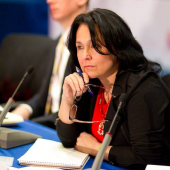Our primary areas of work at Maryland Latinos Unidos (MLU) involve the removal of barriers to increasing access to services that help our quickly growing community grow and thrive. MLU members’ areas of greatest concern include healthcare access, educational quality, immigration reform, environmental justice, economic advancement, and of course – racial and social justice.
Our vision as an organization is that the Latino community in Maryland thrives, achieves excellence, and continually makes progress economically, socially, and environmentally. Latinos should have a seat at the table in policymaking and a voice in communities across the state and everywhere it matters.
Education is the foundational piece to improving all components of what are referred to as Social Drivers of Health (SDOH). The Latine community in Maryland is very young, and though concentrated in five counties, the median age is 29.3, all counties are experiencing rapid increases of young Hispanic students entering the school system creating considerable shifts in student bodies. In charting enrollment trends in Howard County, the data show a steep decline in the number of white students, with steady increases in the number of Black, Asian, and Hispanic students. In Montgomery County, the number of Hispanic students has actually surpassed the number of white students. While the number of Hispanic students increased by similar amounts in both Baltimore City and Baltimore County, the number of Black students decreased in Baltimore City while growing in Baltimore County.ii Young Latines now represent 21 percent of the total student body in Maryland posing significant new challenges for administrators and teachers.
In 2022, MLU testified before the Prince George’s Board of Public Education. Prince George’s student body is now almost 40 percent Hispanic – 39.32% to be exact or 51,561 students. Of these, approximately 21 percent are English Language Learners (ELLs). We also know that the share of the school-age population (ages 5-17) living in poverty is about 15,002 students and that some 66.46% of the total student body receives free and reduced meals. An examination of the 2021 MCAP demonstrated that system-wide: the percent of Latino students who were on grade level for 3rd grade English Language Arts proficiency is 5%. Less than 5% of Latino students were at grade level for Algebra. During the pandemic, there were indications that 52% of Hispanic elementary students were failing at least one core class. Sadly, similar types of challenges exist across the state.
What do these numbers tell us? What can we infer from them?
The first inference is that in terms of Social Drivers of Health (SDOH), the likelihood of accompanying poor health outcomes is likely – meaning there is ample evidence demonstrating the link between healthcare outcomes, education, and economic impacts. Research indicates that limited language skills and low literacy skills are associated with lower educational attainment and worse health outcomes.iv If you don’t speak English well, you are also more likely to make less money. If you have less education, you are likely unable to access better-paying jobs. Education marks the future of the community, but it also enhances what is going on presently.
In the summer and fall of 2022, MLU surveyed over 250 Latine community members in Prince George’s and Anne Arundel counties. We discovered that more than 50 percent of the adults interviewed related to health literacy, had not completed secondary education – meaning high school. We also found that about 52 percent of them had received their first Covid19 shot and more than 50 percent of those who had not, would consider the vaccination. However, about 30 percent were completely against the vaccination and approximately 20 percent did not believe that Covid19 was a fatal disease. In addition, over 80 percent did not speak English well and would consider being vaccinated if they had easy access to a vaccination site or primary care.
Disparities in access to primary care exist, and many people face barriers that decrease access to services and increase the risk of poor health outcomes. Some of these obstacles include lack of health insurance, language-related barriers disabilities, inability to take time off work to attend appointments, geographic and transportation-related barriers, and a shortage of primary care providers – an issue that is raised by almost every single county in the latest Health Equity reports submitted to the State Health Equity Resource Commission.x These barriers may intersect to further reduce access to primary care.
Lastly, in most of the counties, MLU works in, but particularly in those counties where housing is limited and expensive, we find that Latine communities are living in frontline areas and frontline adjacent areas or fenceline areas. A fenceline community or frontline community is a neighborhood that is immediately adjacent to a company, military base, industrial or service center and is directly affected by the noise, odors, chemical emissions, traffic, parking, or operations of the company. What we also learned is that these frontlines or fenceline communities are also most likely to be disproportionately impacted by chronic health conditions like asthma and bronchitis, diabetes, and other circulatory and vascular challenges directly related to their environment and living conditions.
The cumulative impacts of these challenges affect Latine communities across the state. But, we are hopeful that with adequate representation, adequate language access, cultural competency in services, and community education and awareness, representation in key decision-making positions, MLU and its partners can help create the changes necessary to improve our collective outcomes as Latine communities and for all Maryland residents.
We envision a world where communities are welcoming, and language access is universally available for services that are needed by the Latino community, immigrants, and families. Where grassroots leaders and nonprofits are well-supported agents of change, caring for communities, and leading community advancement and policy change. And that means that key indicators of well-being are on par with the majority population, including health, education, environmental impacts, employment, and business creation.

